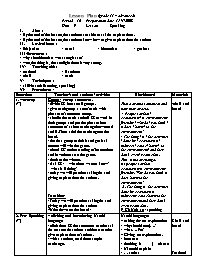Bài soạn môn học Tiếng Anh 11 - Period 76 - Unit: 9 Lesson: Speaking

I. Aims :
- By the end of the lesson, the students are able to ask for explanations.
- By the end of the lesson, the students know how to give explanations for actions
II. Lexical items :
- life jacket - canal - binoculars - get lost
III- Structures :
- why should tourists wear sunglasses?
- wee, the thing is, the sunlight there is very strong.
IV- Teaching aids:
- textbook - Handouts
- chalk - cards
V- Techniques :
- skill-based ( listening, speaking)
VI- Procedures :
Bạn đang xem tài liệu "Bài soạn môn học Tiếng Anh 11 - Period 76 - Unit: 9 Lesson: Speaking", để tải tài liệu gốc về máy bạn click vào nút DOWNLOAD ở trên
Lesson Plan (grade 11 – advanced) Period : 76 Preparation date :15 /1/2008 Unit : 9 Lesson : Speaking Aims : - By the end of the lesson, the students are able to ask for explanations. - By the end of the lesson, the students know how to give explanations for actions Lexical items : - life jacket - canal - binoculars - get lost III- Structures : - why should tourists wear sunglasses? - wee, the thing is, the sunlight there is very strong. Teaching aids: - textbook - Handouts - chalk - cards Techniques : - skill-based ( listening, speaking) Procedures : State/time Teacher’s and students’ activities Blackboard Materials 1. warm-up (7’) Games: cut-up sentences. - divide SS into small groups. - give each group a set of cards with phrases of sentences cut up. - shuffle the cards and tell SS to work in their groups and put the phrases into sentences of a short exchange between A and B. Then stick the exchange on the board. - the first group to finish and get it al correct will win the game. - check SS’ understanding of instructions and have them start the game. - declare the winner. - Ask SS : + what does want to know? + what is B doing? - today we will practice asking for and giving explanations for actions. Transition: - Today we will practice asking for and giving explanations for actions -Write down on the board : These are the sentences and how they are cut: - People say that / ecotourism / is environment-friendly / why do / you think / it does / harm / to the environment? - The thing / is / the activities / done by / eco-tourists/ indirect / cause / harm / to the environment / and they don’t even / realize this. This is the exchange: A: people say that ecotourism is environment-friendly. Why do you think it does harm to the environment? B: The thing is, the activities done by eco-tourists indirectly cause harm to the environment and they don’t even realize this. P 83: Unit 10 : speaking -chalk and board 2. Pre- Speaking (7’) * eliciting and introducing Useful language - elicit from SS the structures used to ask for reasons for actions and those used to give explanations of actions. - with a student, read the example exchange. * completing the brochures ( task a, p.132 – 133) - tell SS to complete the brochures for tourists in task a using the information in the box and the tour guide’s notes. - ask SS to compare answers with a partner - go over the answers with the class. Useful language: * asking for an explanation - why should (not).? - what . For? * Giving an explanation. - because - the thing is } + clause - if I could explain - so that - .... So as to / so as not to - in order to/in order not to Chalk and board Textbook 3. while-Speaking. (15’) 4. Post-Speaking (15’) 5.Homework(1’) Activity 1: Advantages and disadvantages – Information Gap ( task b, p. 145) - pair off SS as A and B - deliver cards A to students A, and cards B to students B ( appendix 2) - ask SS to work in pairs , talking about the advantages and disadvantages of the sources of energy. SS with a gap in the explanation will ask for clarification, and SS with full information will make clarification. - model an example exchange with a student and then have SS so the task. - go around to monitor and note down errors if any for correction late. - call on some close and open pairs to act out their conversations in front of the class. Activity 2: personalization (task c, p.145) - ask SS to work in pairs, talking about the advantages and disadvantages of the cooking fuels and transportation fuels currently used in their home or neighborhood. - act out the example exchange with a student as a model. - have SS start the activity. - go around to monitor and give help with vocabulary or ideals if necessary. - call on some pairs to act out their conversations and invite SS to give comments - give feedback and comments. Listening: -read out mixed expressions of how to do something - SS listen and write down Sentence Making - Ask Sts to make a few sentences about giving instructions Textbook cads textbooks
Tài liệu đính kèm:
 p76.doc
p76.doc





